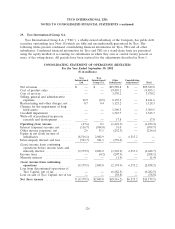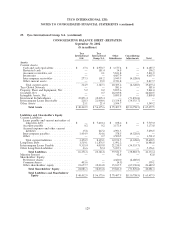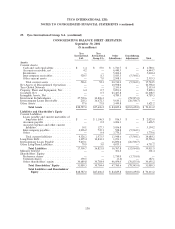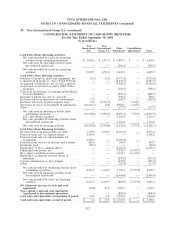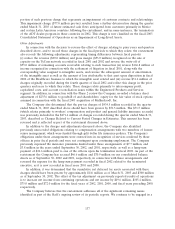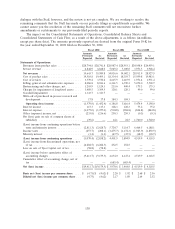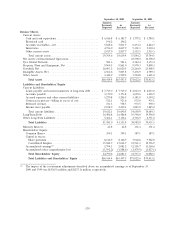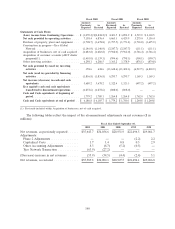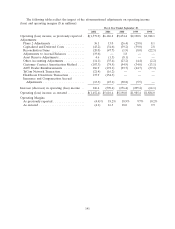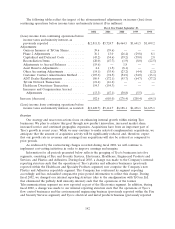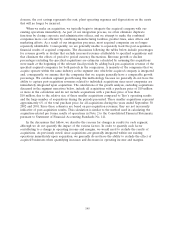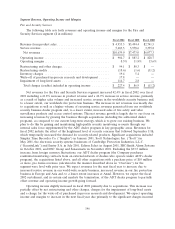ADT 2002 Annual Report Download - page 138
Download and view the complete annual report
Please find page 138 of the 2002 ADT annual report below. You can navigate through the pages in the report by either clicking on the pages listed below, or by using the keyword search tool below to find specific information within the annual report.periodic reconciliations were deficient, resulting in adjustments primarily related to the Engineered
Products and Services segment. Additionally, charges related to the correction of balances primarily
related to corporate pension and deferred compensation accruals, asset reserve adjustments and other
accounting adjustments (i.e., purchase price accounting accruals, deferred commissions, accounting
related to leases in the Fire and Security Services and Engineered Products and Services segments).
The restatement includes adjustments to reverse the charges recorded in the quarter ended March 31,
2003 and reflect those charges in the historic periods to which they relate.
Method of Amortizing Contracts and Related Customer Relationships
As described in Note 1 to the financial statements, the Company purchases residential security
monitoring contracts from an external network of independent dealers who operate under the ADT
dealer program. The purchase price of these customer contracts is recorded as an intangible asset (i.e.,
contracts and related customer relationships), which is amortized over the period of the economic
benefit expected to be obtained from the customer relationship. Effective January 1, 2003, and as
disclosed in the Company’s previously filed Form 10-Q for the quarter ended March 31, 2003, the
Company changed its method of accounting for the amortization of the costs of these purchased
contracts from the straight-line method to an accelerated method. In addition, the Company revised its
estimate of the life of the customer account pool over which the costs of purchased contracts would be
amortized from ten years to twelve years. The change in method of accounting was viewed as
inseparable from the change in estimated life, and therefore, the pre-tax cumulative effect of this
charge of $315.5 million was recorded as an increase in amortization expense effective January 1, 2003.
The restatement reverses this previously recorded charge and reflects the accelerated amortization
method for all historical periods.
Amounts Reimbursed from ADT Dealers
As described in Note 1 to the financial statements, the Company incurs costs associated with
maintaining and operating its ADT dealer program, including brand advertising costs and due diligence
costs relating to contracts offered for sale to the Company under the ADT dealer program. Dealers pay
the Company a non-refundable amount for each of the contracts sold to the Company representing
their reimbursement of such dealer program costs. Prior to fiscal 2002, the Company recognized as an
expense reduction the entire amount of such reimbursements from dealers. Commencing October 1,
2001, to the extent that the amount of dealer reimbursement exceeded the actual costs incurred by the
Company, the excess was recorded as a deferred credit and amortized on a straight-line basis over ten
years. As disclosed in the Company’s previously filed Form 10-Q for the quarter ended March 31, 2003,
the Company changed its method of accounting for these reimbursements from dealers. Pursuant to a
recently issued consensus of the FASB’s Emerging Issues Task Force (EITF 02-16, ‘‘Accounting by a
Customer (Including a Reseller) for Certain Consideration received from a Vendor’’), the consideration
received by the Company relating to the non-refundable charge to each dealer for reimbursement of
the costs to support the ADT dealer program was presumed to be a reduction in the capitalized
intangible asset cost to the Company of acquiring customer contracts. As permitted under EITF 02-16,
the Company changed its method of accounting for the amounts received from dealers for
reimbursement of the costs to support the ADT dealer program through a cumulative change recorded
retroactively to the beginning of the fiscal year. This was reported as a $206.7 million after-tax
($265.5 million pre-tax) charge for the cumulative effect of change in accounting principle in the
Consolidated Statement of Operations for the six months ended March 31, 2003, retroactive to
October 1, 2002. The impact on the Consolidated Balance Sheets of the cumulative adjustment was a
decrease in net intangible assets of $566.8 million and a decrease in liabilities for the previously
deferred non-refundable charge to dealers of $301.4 million. The restatement reverses the cumulative
effect of the previously recorded change in accounting to report non-refundable dealer reimbursements
as a reduction in the capitalized intangible asset cost to the Company of purchasing customer contracts
in each prior accounting period to which such purchases relate, and changes the classification of the
136


